Meet the guide and the best recipe for how to make black beans from scratch, and also learn about the fast way. This simple Brazilian black beans recipe is rich, creamy, and full of flavor. It’s one of those budget-friendly, easy freezer meals made mainly with pantry ingredients that will become a family favorite -- just like our feijoada recipe and vegetarian feijoada!
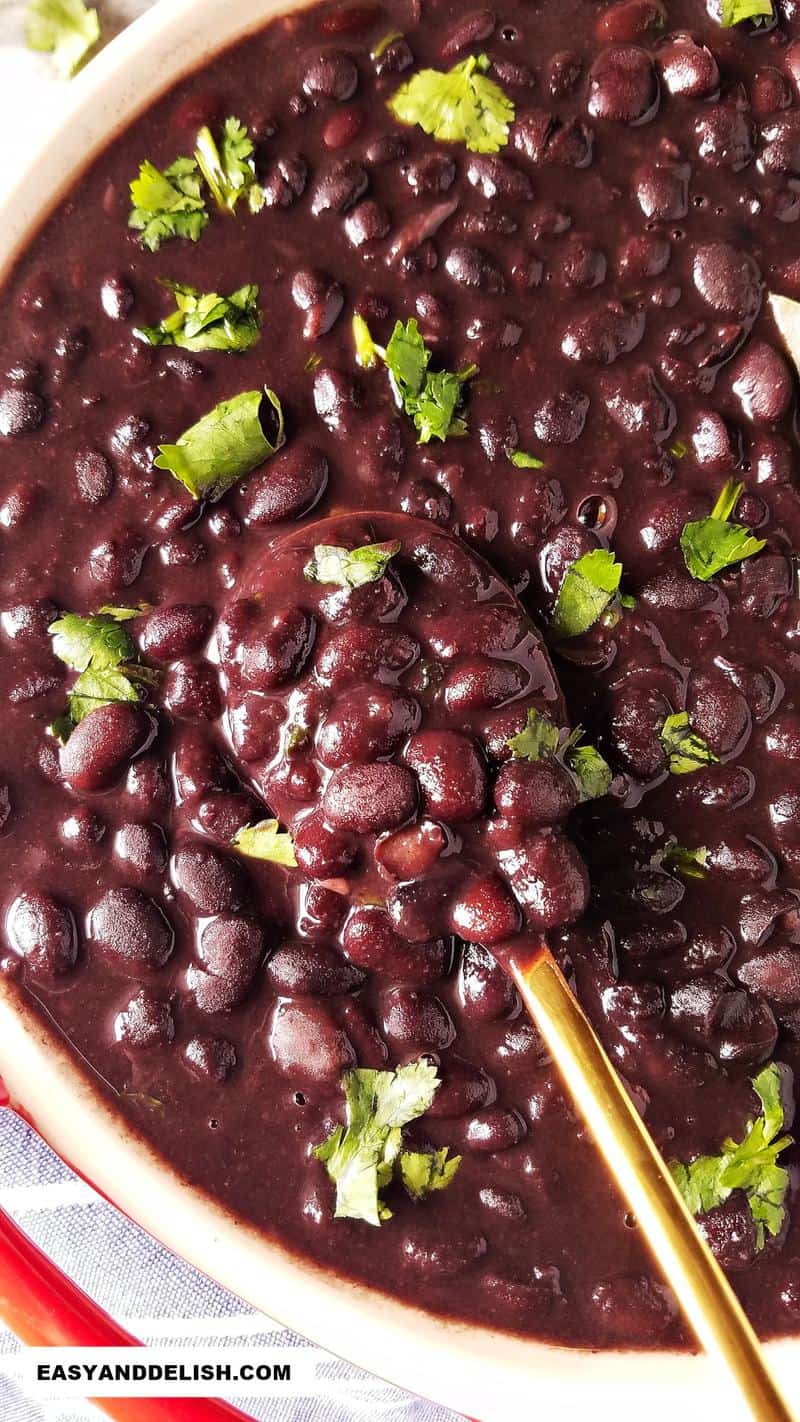
Table of Contents
- 1 How to make black beans (from scratch)
- 2 How to cook black beans fast (from a can)
- 3 Why You'll Love This Recipe
- 4 Reason to love black beans
- 5 Black Bean Seasonings
- 6 Black Beans: Yield & Conversions
- 7 Soaking Methods
- 8 4 Steps to Soaking Dry Beans
- 9 FAQ’s about Beans
- 10 Old Beans and Hard Water Issues
- 11 Top 10 Tips for Cooking Dry Black Beans
- 12 Flavor-boosting Tips
- 13 Storage
- 14 Other Black Beans Recipes:
- 15 How to Make Black Beans (from scratch and fast)
How to make black beans (from scratch)
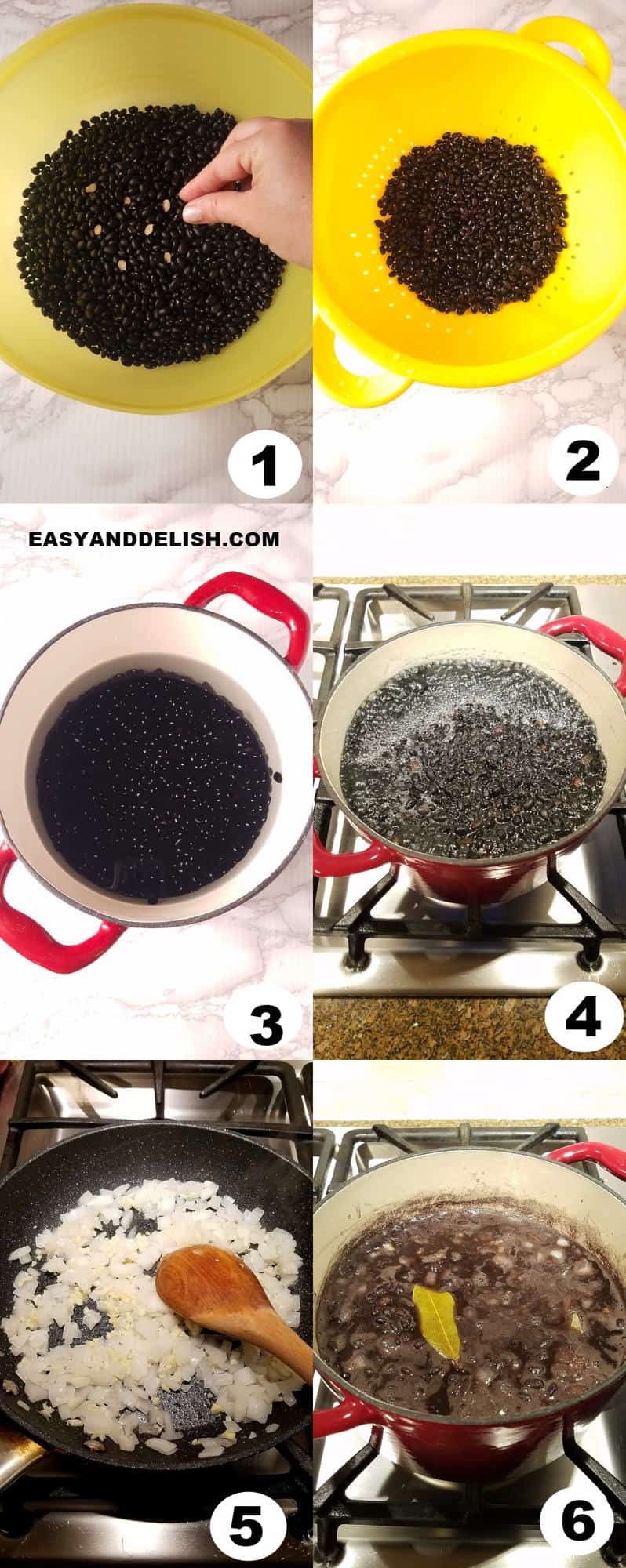
- Sort the beans and discard any stones or damaged beans. SEE PIC. 1
- Wash the beans in a colander. SEE PIC. 2
- (OPTIONAL) Then soak them in 3 times their volume of cold water for at least 4 hours or overnight (12 hours or more) so they will become more tender and cook faster.
- Rinse black beans and drain Reserve.
- Cook beans: In a large, heavy-bottom pan over medium-high heat, bring the beans with 6 cups of water and 1 tablespoon of oil to a boil. Oil reduces foaming during the cooking process! SEE PICS. 3 and 4
- Then, cover the pan and reduce heat to medium-low. Let simmer for 60 minutes or until almost tender.
- In a separate nonstick pan, heat 1 tablespoon of oil over medium heat and cook the diced onion until translucent, stirring now and then. Next, add the garlic and cook for about 60 seconds, stirring now and then. SEE PIC. 5
- Mix the cooked onion and garlic into the almost-cooked beans (about 30 minutes before the cooking time comes to an end). Add the bay leaves, and stir in all the seasonings, spices, and vinegar. The vinegar improves taste and reduces gassy elements. If salt is added at the beginning, it’ll toughen the beans.
- Add 1 to 2 cups of water more, if needed. Cover and let simmer over medium-low heat for those 30 final minutes or until tender. SEE PIC. 6
- Stir and remove the bay leaves. If desired, remove about 1 cup of cooked black beans (grains and broth) and blend in a blender until smooth.
- Add back to the cooked beans and stir. This will make the beans thicker and tastier. Right before serving, sprinkle on the chopped cilantro or parsley if you want. Serve over white rice (a staple in Brazil) and with your fave meat, or use it as a base for black bean soup and dips.
NOTE: If cooking black beans in a pressure cooker (something very common in Brazil), make sure the pot is no more than half full of ingredients, including water. Soaked beans may be cooked in about 15-20 minutes, while unsoaked beans usually take 30-40 minutes or so to cook, depending on how old the beans are. The truth is the older the beans, the more cooking time is required. When making black beans in a pressure cooker, after cooking for 30 minutes (unsoaked beans), do a quick release. Then, add cooked onion and garlic, seasonings, bay leaves, and vinegar. Press the sauté function and let cook for 10 minutes, uncovered.
How to cook black beans fast (from a can)
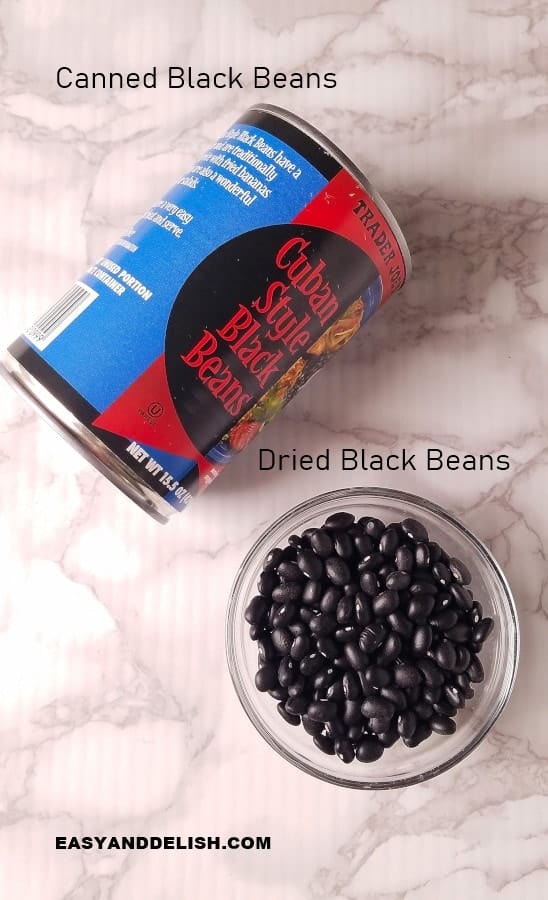
- The quickest way is to doctor up canned black beans. To do this, sweat the onion with oil over medium heat, stirring every now and then, for about 4 minutes.
- Then cook the garlic for about 1 minute. Add the canned beans and stir in cumin (and other seasonings such as salt and pepper).
- Simmer for 10 to 15 minutes. Stir in a shot of red wine vinegar and serve with chopped cilantro.
How to cook black beans in the crockpot
If you are asking yourself how to cook black beans in the slow cooker, no worries! Here is a third way on how to prepare them.
- First, sweat onion and garlic to maximize flavor.
- After that, just dump the rest of the ingredients (except the salt, vinegar, and cilantro) into the crockpot and cook on high for 3-4 hours or low for 6-8 hours.
- Test at the 3 or 6 hours mark to check for doneness. You may need to add about 1 cup more water because it evaporates since beans cook for many hours.
- Half an hour before the cooking time comes to an end, stir in the salt and vinegar. Cover and let it cook.
- Stir and remove the bay leaves. If desired, remove about 1 cup of cooked black beans (grains and broth) and blend in a blender until smooth.
- Add to the cooked beans, stir, and serve with cilantro.
Why You'll Love This Recipe
- Black beans are traditional Brazilian food and a staple in my home country of Brazil. This is one of many reasons why you will find many black bean recipes in this blog that use either canned or dried beans.
- Although home-cooked beans are more flavorful than canned black beans, you can still doctor up canned black beans using the right seasonings, as you’ll see here as well. This recipe is vegetarian, vegan, and gluten-free!
Reason to love black beans
- They are good for you: black beans are a source of plant-based protein and fiber. Moreover, they contain folate, thiamin (vitamin B1), phosphorus, manganese, and magnesium. If you have ever heard that beans are “unhealthy,” it might be because beans contain lectins, an anti-nutrient, until they have been fully cooked. Lectins are present in many plant-based foods, but if you eat fully cooked black beans you won’t have anything to worry about. Read all about black bean nutrition here.
- They are inexpensive: a 15-oz can of black beans costs around $ .70 cents and a 16-oz package of dried black beans about $.99 cents. The first yields approximately 2 cups and feeds 2 people and the second yields 5 cups and feed at least 5 people. Of course, prices may vary depending on location and where you buy them. Also, be aware that organic black beans cost more.
- Black beans can be made ahead and frozen for up to 6 months.
- Available worldwide. But they are most popular in Central and South American cuisines, as well as the Caribbean. Some places are Brazil (feijão preto), Cuba (frijoles negros), Guatemala, Venezuela (caraotas negras), Puerto Rico, Mexico, among others.
- They are versatile. You can eat them as a side, as a vegetarian main dish, or you can incorporate them in other dishes such as tacos, enchiladas, burritos, salads, and more.
- Can be prepared on the stovetop, slow cooker, pressure cooker or Instant Pot, braised in the oven, or mashed and refried for refried beans.
Black Bean Seasonings
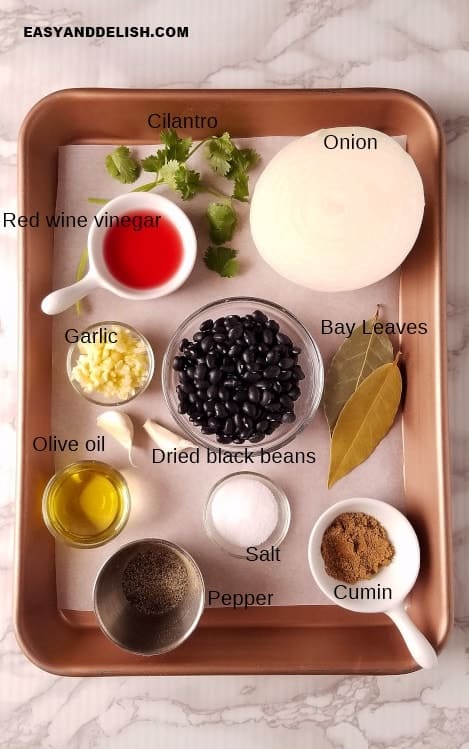
Many black bean recipes call for bacon or lard, but our bean recipe is free of meat products (it’s both vegetarian and vegan). The spices that we used are common in Brazil and make a soulful healthy dish.
Although you can add, omit, or replace one or more of the seasonings, I advise you to try ours first and adjust as you wish.
- Onion and garlic lend a solid base to these beans. Both are sweated to release their natural oils and maximize flavor. After the beans are fully cooked, they will be partially blended in a blender along with the cooked beans, making the dish even more flavorful.
- Bay leaves add an herbal flavor similar to oregano or thyme. Along with onion and garlic make a Portuguese/Brazilian sofrito or refogado (a type of mirepoix).
- Olive oil (just enough to cook the onion and garlic) makes these beans also cook up nicely and add flavor.
- Salt and pepper add a savory taste to these beans and are essential in savory cooking.
- Ground cumin adds a cozy, earthy, and mild smoky flavor to black beans.
- Red wine vinegar for acidity that beans naturally crave and also helps with gases.
- Cilantro, a common herb in Latin America that lends a touch of freshness to the beans before serving. You may replace it with parsley.
Right before serving, you can also squeeze lime juice to brighten up the flavors of the whole dish. Beans love acidity!
Black Beans: Yield & Conversions
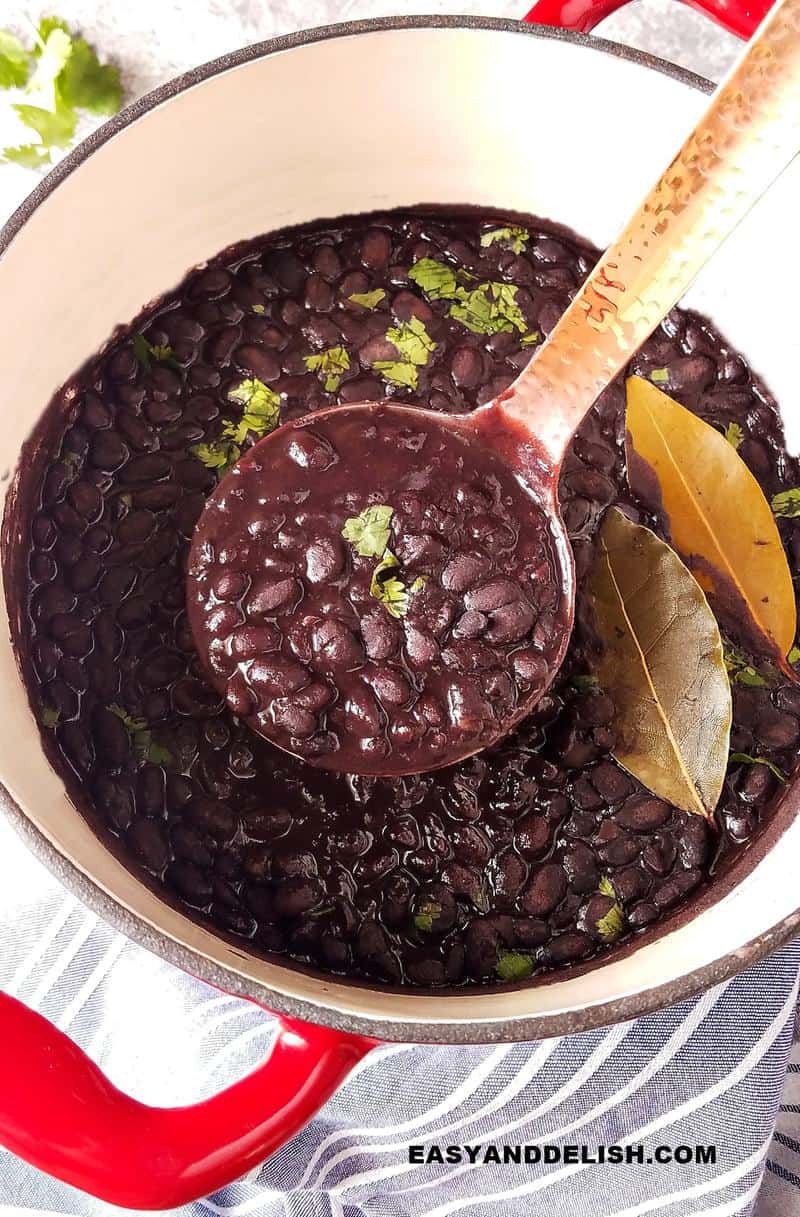
Dried black beans are often sold in one-pound bags. This recipe calls for the whole bag and yields about 6 cups. If you won't be able to finish off that amount of beans within 5 days, you can either halve the recipe or freeze leftovers for up to 6 months.
Here are some helpful measurements and cooking conversions:
- Raw or dried black beans: 1 pound = 16 ounces or 454 grams = about 2 ½ cups
- 1 pound dried black beans = about 6 cups cooked black beans = a little more than 3 (15-oz) cans of cooked black beans
- Every 1 ¼ cups of dried beans yields about 3 cups of cooked beans
Soaking Methods
There are basically 3 different soaking methods that vary in the amount of time required for proper soaking. The “hot soak” method is my favorite because it reduces cooking time and gas-producing compounds the most while yielding tender beans.
- Traditional Soaking (most common):
- Pour cold water over the beans to cover.
- Soak beans for 8 hours or overnight.
- Drain beans and discard the soak water
- Rinse beans with fresh, cool water.
Advantages:
No boiling required, and reduces gas-producing compounds with a long soak.
Disadvantages:
Long soaking time, requiring planning ahead of time
- Hot Soak (preferred):
- Place beans in a large pot and add 10 cups of water for every 2 cups of dried beans.
- Heat to boiling and boil for additional 2-3 minutes.
- Remove beans from heat, cover, and let stand for 4 to 24 hours.
- Drain the beans and discard soak water.
- Rinse beans with fresh, cool water.
Advantages:
Reduces cooking time and gas-producing compounds; consistently yield tender beans
Disadvantages:
Long soaking time, requiring some planning.
- Quick soaking (most convenient):
- Place beans in a large pot and add 6 cups of water for every 2 cups of dried beans.
- Bring them to a boil and cook for 2-3 minutes longer.
- Remove beans from heat, cover, and let stand for 1 hour.
- Rinse beans with fresh, cool water.
- Drain the beans and discard soak water.
- Rinse beans with fresh, cool water.
Advantages:
Much faster soaking time, requiring less planning.
Disadvantages:
Fermentation may take place if left in hot water for too long and also has the potential loss of some folate.
4 Steps to Soaking Dry Beans
First, inspect the dry beans, removing any broken beans or foreign materials.
Rinse thoroughly in cold water.
Next, use one of the soaking methods mentioned above. If using the preferred “hot soak” method: Add 10 cups of cold water to the pot for each pound (2 cups) of dried beans. Bring the water to a boil and boil 2-3 minutes, cover the pot, and let stand for 4-24 hours. Remove beans from heat, cover, and let stand for four to 24 hours.
Finally, drain and rinse the soaked beans. Cook and use in recipes.
FAQ’s about Beans
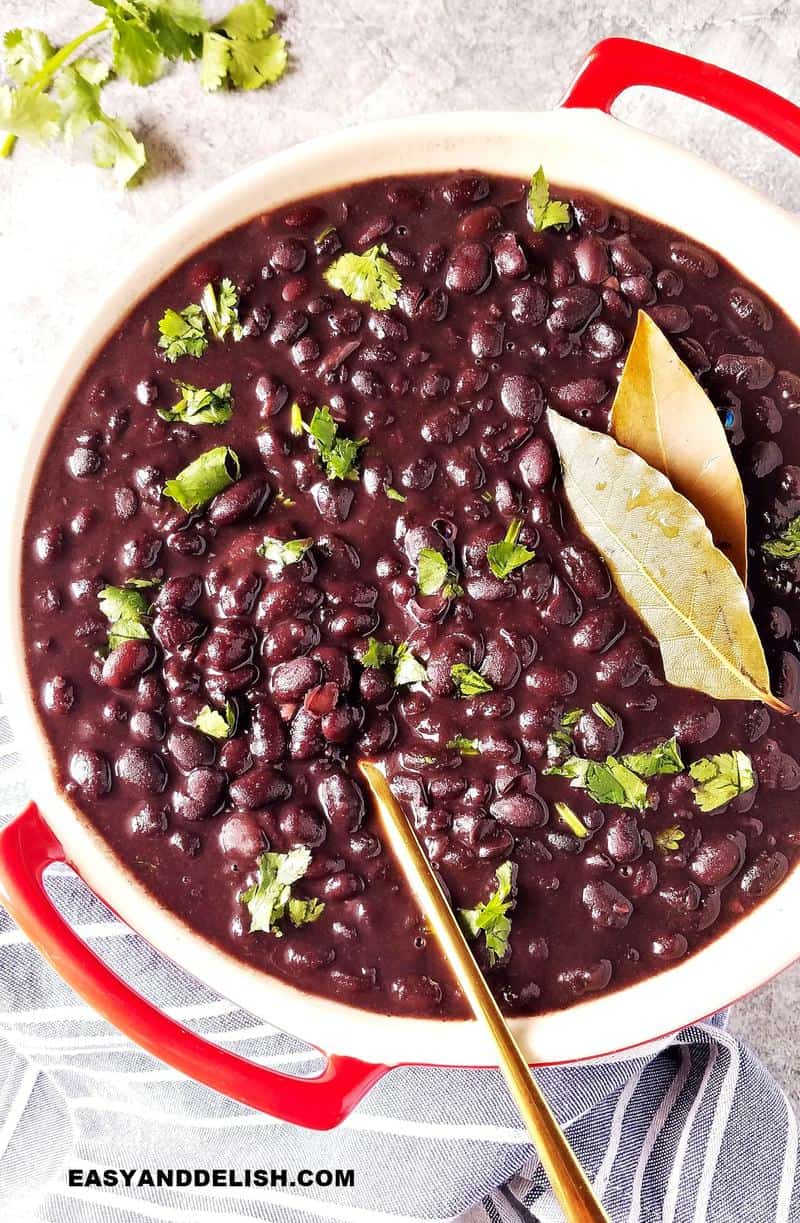
Should beans be soaked or not?
Beans are traditionally soaked using one of the 3 soaking methods cited above. But some like Kenji Lopez on Serious Eats bring out valid arguments why not to soak beans. According to him, un-soaked beans will require only 20-30 minutes longer on the stove, will have a deeper color, and hold more nutrients and a better flavor.
In the era of the Instant Pot or pressure cooker, I confess that I allow myself to skip the soaking step. Even if cooking them on the stovetop, you can always add ½ teaspoon of baking soda for every pound of dried beans to soften faster.
But we must say one of the reasons beans are usually soaked is not only to soften them. It is also to help with gases -- although you can always take an anti-gas tablet to reduce flatulence.
Must salt be added before or after cooking?
It’s true that salted beans tend to have a better flavor. But I don’t agree that unsalted beans are to blame for split skins. Simmering beans instead of rapid boiling them is the step that really prevents split skins. If you intend to cook them in the pressure cooker, make sure to use new beans and filtered/distilled water, and also to NOT soak them. These will help the beans to not wind up with split skin under pressure.
You may add salt before cooking and produce less broth, or you may add salt half an hour before the cooking time comes to an end. But the reality is, salt tends to toughen beans. So adding salt 30 minutes before the cooking time ends will let black beans become tender while still turning out tasty. That's the way to go!
Is it best to cook beans on the stovetop or in the pressure cooker (Instant Pot)?
You can cook beans either way. But to avoid split skin and produce more flavorful beans, cook them on the stovetop. Moreover, water can evaporate during cooking, resulting in a more condensed and thick broth – opposite to what happens in the Instant Pot.
Some think the Instant Pot or pressure cooker should be reserved for when you are in a hurry. According to them, beans may cook unevenly because they may run out of water during the cooking process. Plus, overcooking them is not uncommon and they become mushy and bland.
I agree partially with them. Yes, what they say can happen but only if you don’t take the following measures:
- Add 6 cups of water to every pound of dried beans. This will be enough water to prevent the beans running out of liquid. If you wish, consult our volume conversions page.
- To prevent mushy beans, do NOT soak the beans. Moreover, cook new beans in distilled or filtered water for about 30 minutes under high pressure. Then do a quick release and simmer them (press the sauté button), uncovered, for about 10 minutes. These steps will prevent mushy beans or split skins.
- The simmering process will allow the beans to absorb flavors. Add cooked onion and garlic, seasonings, and vinegar to the beans before simmering them. At the end, blend about 1 cup (broth and beans) in a blender and stir it into the cooked beans. This will make them super tasty! If you wish, sweat extra vegetables and blend with the cooked beans and broth in the blender, adding extra flavor. Plus, add an extra splash of red wine vinegar to bring out even more flavor. Beans love acidity. I find that these are the best ways to doctor up my Instant Pot Black Beans. It works wonders!
Old Beans and Hard Water Issues
If you didn't already know, old beans take longer to cook than new beans. Let's face facts: very old beans may never soften enough.
Black beans take about 60-90 minutes to cook if not old. So when buying dried beans it’s key that you check the bag for the harvest or expiration date. They will be good to cook within a year of harvest.
In addition, store beans in a dark, cool place in the pantry in their package or in an air-tight container labeled with the expiration date. Otherwise, if you don’t remember, you will risk cooking old beans that won’t be tender enough.
Another factor to consider is the minerals in hard water. They can slow the cooking process, making it take about 50% more time for the beans to cook!
So, use filtered or distilled water instead of tap water, unless you have a good water softener at home. You can take a look at hard water areas in the United States.
Top 10 Tips for Cooking Dry Black Beans
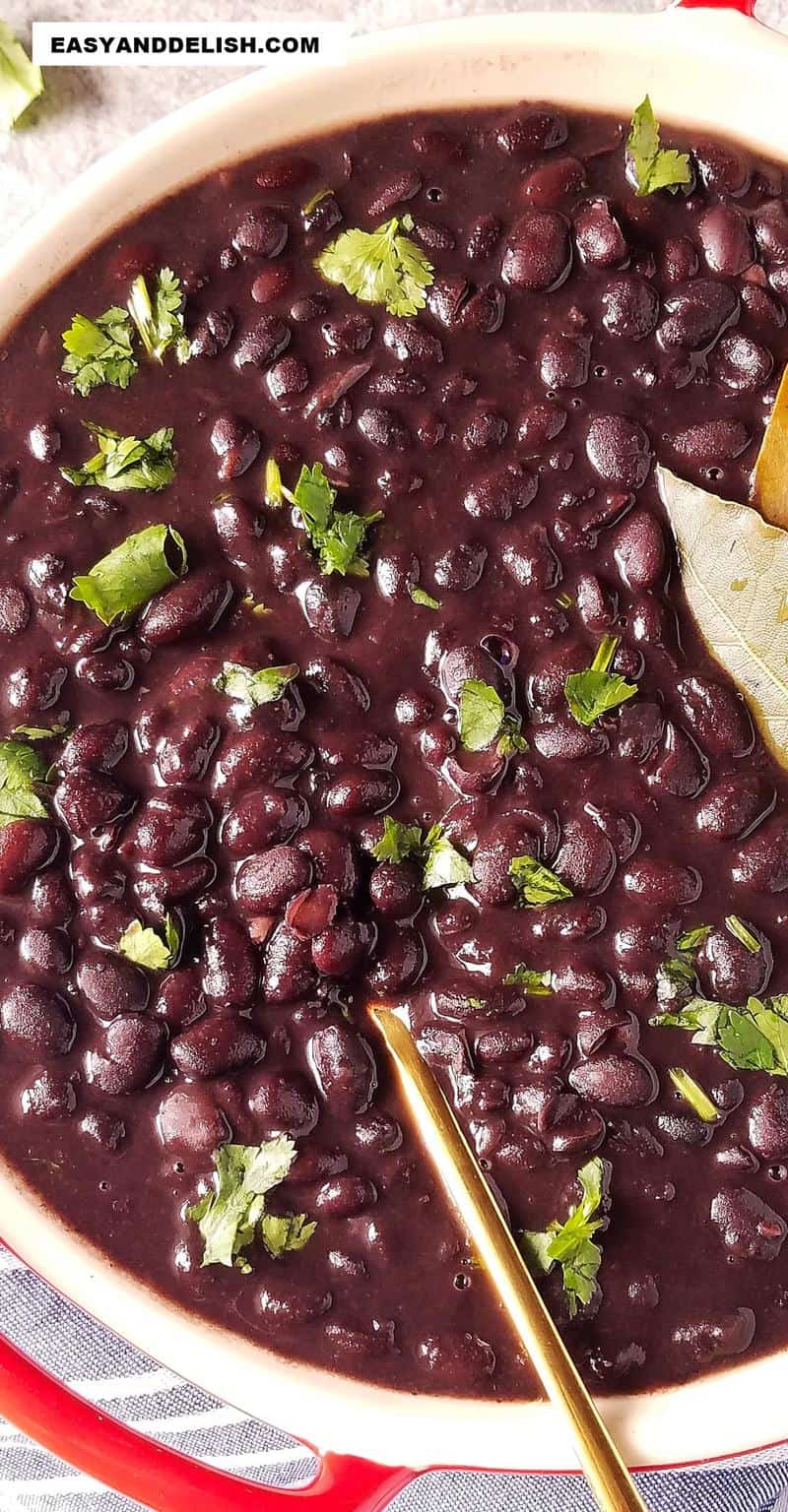
- To cook beans, add cold filtered or distilled water (not hard water) to fully cover beans, plus 1 to 2 tablespoons of oil, if you wish. Adding oil prevents foaming and boiling over. Foam also can be skimmed off during cooking. Simmer the beans until they are tender.
- Cook only one kind of bean at a time if possible. Different types and ages of beans have different cooking times, so avoid cooking different types of beans together at the same time.
- Maintain water at a gentle simmer (not rapid boil) during cooking to prevent split skins.
- Some think adding baking soda to beans makes the beans more tender, but it also destroys the B vitamin thiamine and may impact the flavor negatively. Personally I think it doesn’t alter the flavor – at least I cannot taste the difference!
- Like pasta, stir beans occasionally to prevent sticking during cooking.
- Keep beans covered with water during the cooking process. If needed, add cold water periodically during cooking to ensure the beans are covered.
- Check beans for doneness before eating. When cooked properly, beans should be tender but not mushy. Skins still should be intact, but the beans can be mashed easily between two fingers or with a fork.
- Drain beans right away once they have reached the desired texture in order to prevent overcooking --but only if you will be using them in salads or other dishes where the broth is not needed.
- To add flavor when the beans have almost finished cooking, try adding a drizzle of extra virgin olive oil immediately before serving rather than adding high-fat ingredients (such as bacon) during cooking.
- To cook black beans quickly, try a pressure cooker, following the manufacturer’s instructions. This allows beans to cook in half the time and eliminates the need for soaking. However, this does not give the beans as much time to absorb flavors from other ingredients as when cooked on the stovetop.
NOTE: Hard water (naturally high in minerals) may affect the cooking time/softening of beans. Distilled or softened water may result in a better end product.
Flavor-boosting Tips
Beans tend to absorb the flavors of the ingredients with which they are cooked. Follow these tips when adding each of these ingredients to beans to make them tasty and nutritious:
- Acid: Adding sources of acid is a great way to increase the depth of flavor in bean dishes. Add foods such as lemon juice, vinegar, tomatoes, chili sauce, ketchup, molasses, or wine after the beans have been cooked fully. These acidic foods can prevent beans from becoming tender and lengthen the cooking time if they are added too soon.
- Onions: Adding onions also can increase the depth of flavor in beans. Add onions at any time during the cooking process, but for a stronger onion flavor, add during the last 30 minutes of cooking.
- Herbs and spices: Add oregano, thyme, garlic, parsley, or any other herbs/spices any time during cooking. However, keep in mind that the flavors of herbs and spices tend to diminish the longer they are cooked.
- Salt: Add when the beans have almost reached full tenderness because salt tends to toughen beans. Remember to use minimal amounts of salt to limit the sodium content of beans.
Storage
Allow cooked black beans to cool completely. Then store them in an airtight container in the fridge for up to 5 days, or freeze for up to 6 months.
Other Black Beans Recipes:
- Vegetarian feijoada
- Feijoada Salad
- Black bean soup
- Feijoada recipe
- Black Beans and Rice
- Black bean empanadas
- Chili mac and cheese
- Texas Caviar
- Savory hand pies
- Black bean, corn, and avocado salad
PIN & ENJOY!
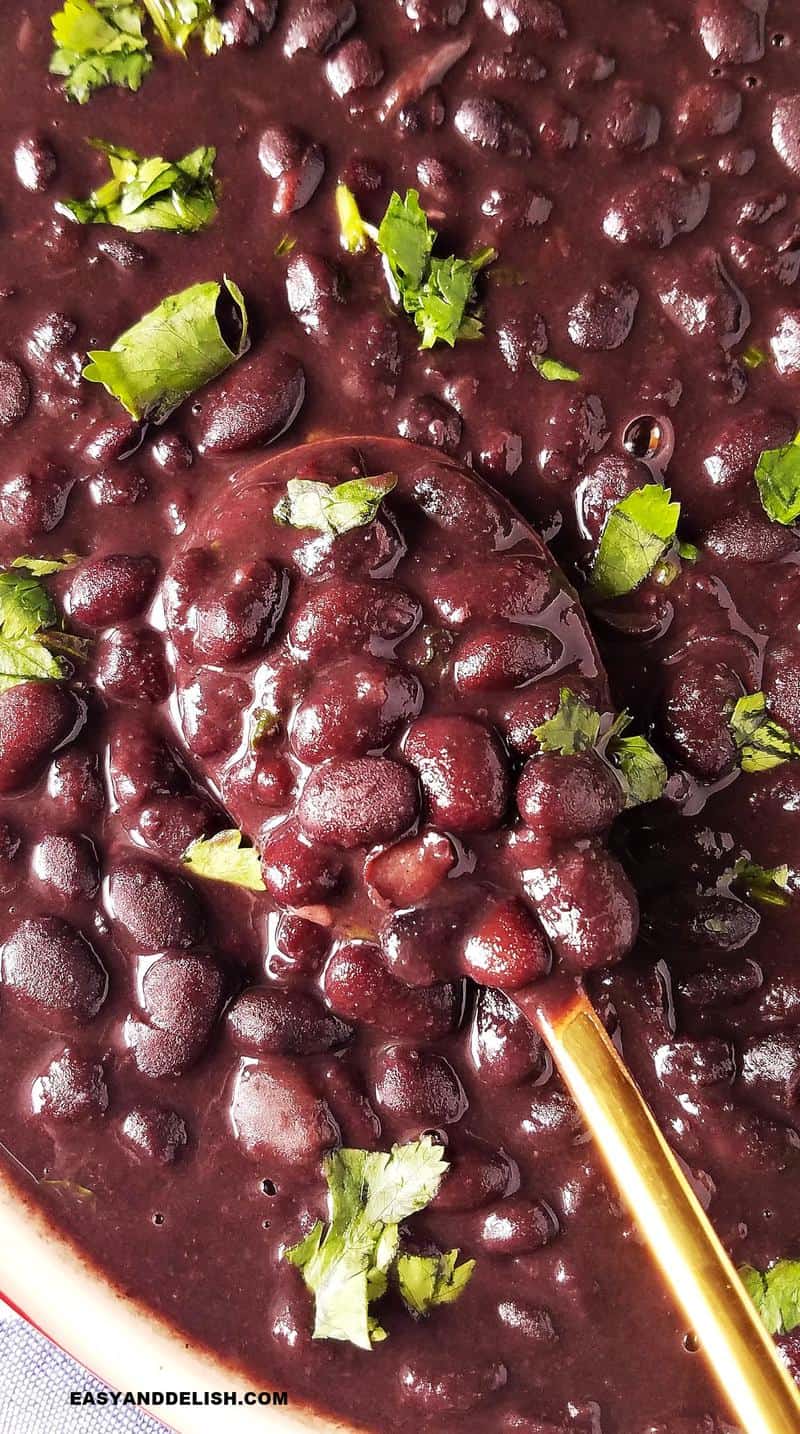
How to Make Black Beans (from scratch and fast)
Equipment
- pot
- cutting board
- knife
Ingredients
- 16 oz dried black beans
- 6 cups water plus 1-2 cups if needed, especially if not pre-soaking beans
- 2 tablespoon olive oil
- ¼ onion chopped
- 4 garlic cloves minced
- 1 tablespoon plus 1 teaspoon salt plus ½ teaspoon pepper use pepper flakes if you enjoy spicy food
- ½ teaspoon cumin
- 2 bay leaves
- 1 tablespoon red wine vinegar
- 2 tablespoon cilantro chopped
Instructions
- Sort the beans and discard any stones or damaged beans.
- Wash the beans in a colander.
- (OPTIONAL) Then soak them in 3 times their volume of cold water for at least 4 hours or overnight (12 hours or more) so they will become more tender and cook faster. Rinse and drain. Reserve.
- Cook beans: In a large, heavy-bottom pan over medium-high heat, bring the beans, with 6 cups of water and 1 tablespoon of oil, to a boil. Oil reduces foaming during the cooking process!
- Then, cover the pan and reduce heat to medium-low. Let simmer for 60 minutes or until almost tender.
- In a separate nonstick pan, heat 1 tablespoon of oil over medium heat and cook the diced onion until translucent, stirring every now and then. Next, add the garlic and cook for about 60 seconds, stirring every now and then.
- Mix the cooked onion and garlic into the almost cooked beans (about 30 minutes before cooking time comes to an end). Add the bay leaves, and stir in all the seasonings, spices, and the vinegar. The vinegar improves taste and reduces gassy elements. If salt is added at the beginning, it’ll toughen the beans.
- Add 1 to 2 cups of water more, if needed. Cover and let simmer over medium-low heat for those 30 final minutes or until tender.
- Stir and remove the bay leaves. If desired, remove about 1 cup of cooked black beans (grains and broth) and blend in a blender until smooth.
- Add the blended beans back to the cooked beans and stir. This will make the beans thicker and tastier. Right before serving, sprinkle the chopped cilantro or parsley, if desired. Serve over white rice (a staple in Brazil) and with your fave meat, or used as a base for black bean soup and dips.
Recipe Notes
- If cooking black beans in a pressure cooker (something very common in Brazil), make sure the pot is no more than half full of ingredients, including water. Soaked beans may be cooked in about 15-20 minutes while unsoaked beans usually take 30-40 minutes and so to cook, depending on how old the beans are. The truth is, the older the beans, the more cooking time required. For cooking black beans in a pressure cooker, after cooking for 30 minutes (not soaked beans), do a quick release. Then, add cooked onion and garlic, seasonings, bay leaves, and vinegar. Press the sauté function and let cook for 10 minutes, uncovered.
- If desired, 6 strips of diced bacon can be cooked and put into the recipe when adding the sauteed onions and garlic as well as the bay leaves, seasonings and spices, and vinegar. This will make the black beans even tastier!
- The quickest way is to doctor up canned black beans. To do this, sweat the onion with oil over medium heat, stirring every now and then, for about 4 minutes.
- Then cook the garlic for about 1 minute. Add 2 (15-oz) cans black beans and stir in cumin (and other seasonings such as salt and pepper).
- Simmer for 10 to 15 minutes. Stir in a shot of red wine vinegar and serve with chopped cilantro.
-
- First, sweat onion and garlic to maximize flavor.
- After that, just dump the rest of the ingredients (except the salt, vinegar, and cilantro) into the crockpot and cook on high for 3-4 hours or low for 6-8 hours.
- Test at the 3 or 6 hours marks to check for doneness. You may need to add about 1 cup more water because it evaporates since beans cook for many hours.
- Half an hour before the cooking time comes to an end, stir in the salt and vinegar. Cover and let it cook.
- Stir and remove the bay leaves. If desired, remove about 1 cup of cooked black beans (grains and broth) and blend in a blender until smooth.
- Add to the cooked beans, stir, and serve with cilantro.
Nutrition
** Nutrition labels on easyanddelish.com are for educational purposes only. This info is provided as a courtesy and is only an estimate, since the nutrition content of recipes can vary based on ingredient brand or source, portion sizes, recipe changes/variations, and other factors. We suggest making your own calculations using your preferred calculator, based on which ingredients you use, or consulting with a registered dietitian to determine nutritional values more precisely.
Please note that health-focused and diet information provided on easyanddelish.com is for educational purposes and does not constitute medical advice, nor is it intended to diagnose, treat, cure, or prevent disease. Consult with your doctor or other qualified health professional prior to initiating any significant change in your diet or exercise regimen, or for any other issue necessitating medical advice.
Post first published on May 18th, 2014, and recently updated.
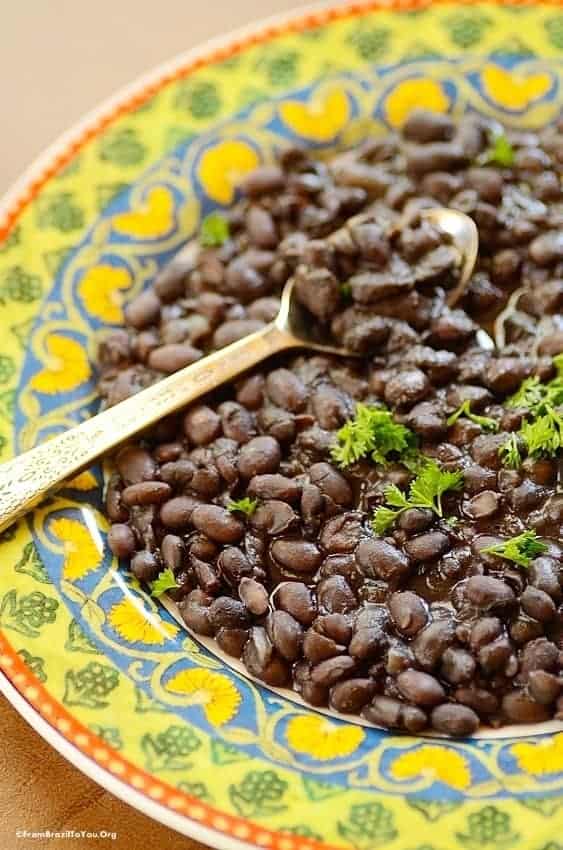




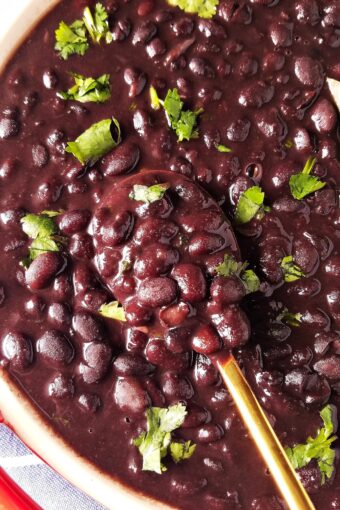
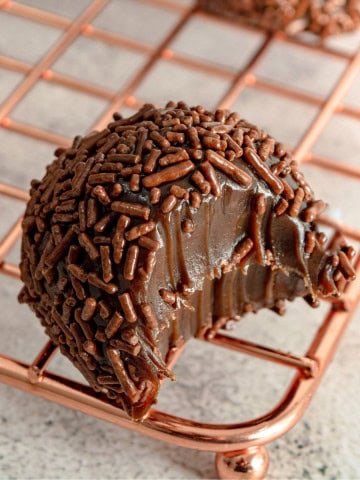
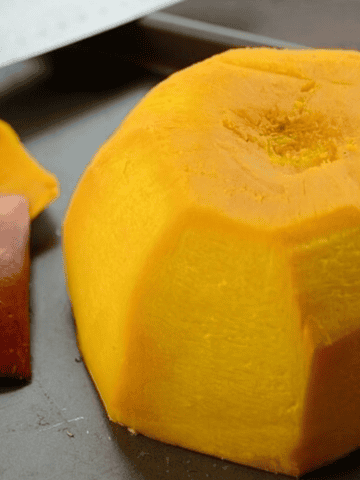

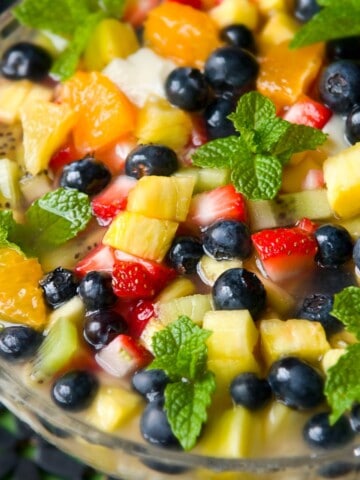
Bailey says
The best black beans that I have ever tasted.
Silvia Martinez says
Black beans are one of my favorite beans to cook, they cook faster than pinto and I love their color. I for sure will add some bacon!
Alejandra Graf says
Black beans are on my fridge always! I'll try your way.
Tiffany says
Bookmarking this recipe for how-to posts!
Enriqueta Lemoine says
I'm loving this blog so much, I do have my own recipe, but will definitely give a try to yours!
ChannonD says
Love love love these recipes. Brazilain Black beans with Rice and Collards is one of my favorite meals. Especially when topped with a little farofa and some homemade chili/garlic oil. Thanks so much for sharing.
Also, as a warning to them and others, when I clicked on the "Secret Recipe Club" link above, a malware pop-up appeared disguised as Google asking me to update to the latest version of Google Chrome. GC will NEVER do that. If I hadn't looked at the url, I would not have caught on. Would you please let the folks at the Secret Recipe Club know?
Thanks again! I LOVE this blog!!
Denise Browning says
Thank you, Channon! I had no idea about the SRC malware pop-up. I do apologize for it.
I left the SRC about one year ago. Time has been quite tight.
Kiran @ KiranTarun.com says
If you know me well, you'd know my love and adoration for making beans from scratch. LOVE this 🙂
Denise Browning says
Thanks, Kiran! I grew up eating beans and love many types.
marcela says
to be honest... i've never tried black bean... looks delicious... both ways 🙂
Denise Browning says
I hope you try to make black beans, Marcela! It is a great source of protein and quite delicious. You can also use them to prepare soups, salads, dips, bean and cheese tacos, etc.
Karen (Back Road Journal) says
It sounds like we could be sisters…this is just the way I cook my black beans as well although I sometimes like to add chopped fresh oregano from my garden.
Denise Browning says
This is a great idea as well, Karen!
Cassis says
I LOVE black beans, much more than brown. This recipe is great, congratulations.
Denise Browning says
Thank you, Cassis! My whole family is crazy for these black beans!Enjoy your weekend!
Lea Ann (Cooking On The Ranch) says
I'll never forget the first time I had black beans. It was about 20 years ago in a Brazilian restaurant in SE Denver. Which by the way is still in business. My pantry has been stocked with black beans ever since. Thanks for the recipes.
Denise Browning says
I am glad that you enjoyed their beans. Black beans are a staple in Brazilian cuisine. Enjoy this recipe, Lea Ann!
Coffee and Crumpets says
Black beans are cooked quite often at my house and I love using the pressure cooker to do it! Thanks for the pointers!
Denise Browning says
In Brazil, pressure cooker is often used as well.
Chantal says
Hi denise,
I'am Chantal from Travelling Papilles a global food blog. I just discover your so beautiful blog via the net and this nice recipe. I usually cook it too as my mother is from Haïti. There are a lot of similar recipes and products between Brazil, Haïti and some part of Africa.
I will come back here from time to time to enjoy your recipes.
Thank you for sharing
Chantal
Denise Browning says
Hi, Chantal! Welcome to FBTY!!
Yes, there are various ingredients and a few dishes that my country and others have in common. I hope you visit us often.
Wishing you a wonderful weekend.
Kumar's Kitchen says
we finally got two delicious new ways of cooking black beans...we usually enjoy it as a curry,thanks for these superb recipes and stunning food clicks as always 🙂
Amira says
I was not a fan of black beans in fact the first time it was introduced to me was almost 12 years ago in Egypt eating in Chilli's and I was like what the heck is that?!!!! and I did not touch it then 🙂 . But when I came here I tried it in several occasions but did not really cook them myself. Thanks for sharing these two fabulous ways to cook them.
Natalia says
Oi Denise, obrigada pela visita!
Eu adorei conhecer o seu site, coisa boa a gente tem que indicar mesmo (:
Beijos
Denise Browning says
Natália: Volte sempre! É muito bom receber a sua visita e de outros brasileiros aqui. Um bom dia pra você!
cquek says
Thanks for a wonderful recipe!
Monet says
How did you know? I just bought a pound of dried beans and I was hoping to find a new recipe to try. Thank you!
Pamela @ Brooklyn Farm Girl says
I could eat black beans for dinner and black beans only, I love them so much! Can't wait to gobble down yours !
John@Kitchen Riffs says
I luv black beans! I use them in soup, as sides, as ingredients in other dishes -- you name it, and I use them. Super post -- thanks.